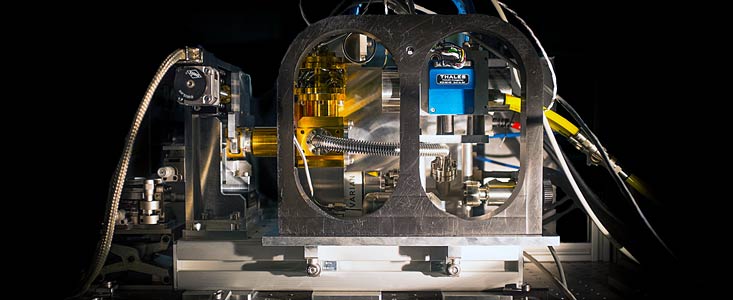Tiedote
Revolutionary New High-speed Infrared Detector Sees First Light
15. kesäkuuta 2015
The first prototype of a new generation of fast and very sensitive detectors has been successfully installed on the PIONIER instrument at ESO’s Paranal Observatory. This achievement is the result of five years of sustained collaboration and effort from academic institutes (LETI, ONERA, IPAG, LAM) and industrial partners (SOFRADIR).
As its name suggests, the new RAPID system [1] delivers several thousand images per second and can operate at very low light levels. These capabilities, unique for an infrared detector, are crucial for many applications, ranging from fundamental science to medicine. In astronomy, it will boost the performance of adaptive optics, a technology at the heart of the European Extremely Large Telescope (E-ELT).
Unlike most of the commercially available detectors, RAPID can spot photons (light particles) of both visible and infrared light (wavelengths from 0.4–3.6 micrometres). This is a tremendous gain; the increased spectral coverage means that far more photons can be gathered, especially from infrared wavelengths, where many objects shine most brilliantly.
In 2013, the partners delivered the first prototypes and, given the performance results of these prototypes, the decision was quickly taken to push for an on-sky demonstration on a demanding instrument. PIONIER was chosen as its interferometric combination of light requires a very fast detector to fight against atmospheric turbulence, and a minimum amount of noise in order to detect faint objects.
The first observations focused on stars of different types (bright giants and faint dwarfs) in order to explore the behaviour of RAPID. These key tests were passed successfully, and the detector was then immediately exploited for purely scientific pursuits.
“It is an historic moment and a true revolution in the field of infrared detectors,” said ESO astronomer Antoine Merand when first using the camera. The lead scientist of the PIONIER instrument, Jean-Baptiste Le Bouquin, adds: “The former detector on PIONIER is more than 20 years old and was still considered among the best of its type. This illustrates how hard we had to work to get this new generation in hand.”
The exquisite sensitivity of RAPID is based on the avalanche effect. Every photon arriving into the detector is converted into many more than one electron, therefore easing its detection. This multiplication is almost perfect, with only a very small amount of excess noise being introduced.
The avalanche effect is obtained without having to cool the detector to extremely low temperatures, avoiding the use of a complex cooling system, which considerably simplifies the detector packaging and operations. As an example, it took only two days for the team to install this brand new revolutionary camera inside PIONIER.
Notes
[1] The RAPID camera was funded by the Fonds Unique Interministériel from the French government (FUI-RAPID). Its installation at Paranal was funded by the Agence Nationale pour la Recherche (ANR-11-LABX-13), with support from ESO.
Linkit
- RAPID: A Revolutionary Fast Low Noise Detector on PIONIER (pdf file)
- Le Bouquin, J.B.; et al. 2011, A&A, vol. 535, article id 67
Yhteystiedot
Jean-Baptiste Le Bouquin
Institut de Planétologie et d'Astrophysique de Grenoble (IPAG)
Grenoble, France
Phone: +33 4 76 63 58 93
Email: jean-baptiste.lebouquin@obs.ujf-grenoble.fr
Jean-Philippe Berger
VLTI Programme Scientist, ESO
Garching bei München, Germany
Phone: +49 89 3200 6630
Email: jpberger@eso.org
Thomas Rivinius
PIONIER Instrument Scientist, ESO Paranal
Santiago, Chile
Email: triviniu@eso.org
Richard Hook
ESO Public Information Officer
Garching bei München, Germany
Tel: +49 89 3200 6655
Cell: +49 151 1537 3591
Email: rhook@eso.org
Tiedotteesta
| Tunnistus: | ann15042 |

